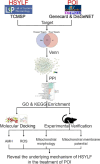Mechanisms of He Shi Yu Lin formula in treating premature ovarian insufficiency: insights from network pharmacology and animal experiments
- PMID: 39731132
- PMCID: PMC11674109
- DOI: 10.1186/s13048-024-01575-1
Mechanisms of He Shi Yu Lin formula in treating premature ovarian insufficiency: insights from network pharmacology and animal experiments
Abstract
Objective: He Shi Yu Lin Formula (HSYLF) is a clinically proven prescription for treating premature ovarian insufficiency (POI), and has shown a good curative effect. However, its molecular mechanisms are unclear. This study aimed to investigate the molecular mechanisms of HSYLF and clarify how network pharmacology analysis guides the design of animal experiments, including the selection of effective treatment doses and key targets, to ensure the relevance of the experimental results.
Methods: Network pharmacology, molecular docking, and animal experiments were utilized to investigate the effects of HSYLF. Key targets were identified by intersecting herb and disease targets to construct protein-protein interaction and "active components-intersection targets-disease" networks. Gene Ontology and Kyoto Encyclopedia of Genes and Genomes pathway analyses were performed using the clusterProfiler package in R. A total of 50 specific pathogen-free female mice of reproductive age were included in the animal experiments. They were divided into five groups: the positive control group, the high-dose HSYLF group, the low-dose HSYLF group, the model blank group, and the normal control group, to evaluate the serum anti-müllerian hormone levels, mitochondrial morphology in oocytes, the levels of reactive oxygen species (ROS), and mitochondrial membrane potential.
Results: Network pharmacology identified 204 active components connecting 219 key therapeutic targets for POI. Gene Ontology enrichment analysis indicated that the anti-POI targets of HSYLF mainly regulated response to xenobiotic stimulus, cellular response to chemical stress, and response to oxidative stress; and the Kyoto Encyclopedia of Genes and Genomes pathway analysis suggested the primary pathways, including lipid and atherosclerosis, advanced glycation end product-receptor for advanced glycation end product signaling pathway in diabetic complications, bladder cancer, tumor necrosis factor signaling pathway, and interleukin-17 signaling pathway. The low-dose (33 g/kg/d) HSYLF and high-dose (66 g/kg/d) HSYLF groups exhibited a marked elevation in serum anti-müllerian hormone levels (low-dose group: 2657.63 ± 354.82 PG/ml; high-dose group: 2823.73 ± 316.04 PG/ml) and mitochondrial membrane potential compared to the model blank group (P < 0.05 or P < 0.01), along with a significant decline in fluorescence intensity of 2',7'-dichlorofluorescein for the levels of ROS in oocytes (P < 0.05 or P < 0.01). Additionally, both groups showed varying degrees of improvement in the morphology, quantity, and distribution of mitochondria.
Conclusion: This study provides definite evidence for the molecular mechanism by which HSYLF treats POI by decreasing mitochondrial ROS, increasing membrane potential, and improving mitochondrial function. The results from active components of HSYLF and their related key targets also confirmed the characteristics of its multi-component, multi-target, multi-pathway, and overall regulatory effects on POI. Further research regarding the mechanisms is required to generalize these results, and the deeper clinical value of HSYLF also needs to be investigated in the future.
Keywords: Active oxygen; He Shi Yu Lin Formula; Mitochondria; Network pharmacology; Premature ovarian insufficiency; Traditional Chinese medicine.
© 2024. The Author(s).
Conflict of interest statement
Declarations. Ethics approval and consent to participate: The animal study protocol was approved by the Animal Ethics Committee of Zhejiang Chinese Medical University for the handling of animals (protocol approval number: 20220639) and conducted in compliance with the institutional guidelines (Directive 2010/63/EU in Europe) for the care and use of animals. Consent for publication: Not applicable. Competing interests: The authors declare no competing interests.
Figures










Similar articles
-
Potential therapeutic drug targets and pathways prediction for premature ovarian insufficiency -Based on network pharmacologic method.J Ethnopharmacol. 2023 Mar 25;304:116054. doi: 10.1016/j.jep.2022.116054. Epub 2022 Dec 13. J Ethnopharmacol. 2023. PMID: 36526095
-
Network Pharmacology, Molecular Docking, and Experimental Validation on Guiluoshi Anzang Decoction Against Premature Ovarian Insufficiency.Comb Chem High Throughput Screen. 2025;28(4):724-736. doi: 10.2174/0113862073291139240506114446. Comb Chem High Throughput Screen. 2025. PMID: 38757315
-
Network pharmacology and experimental validation to explore the molecular mechanisms of Bushen Huoxue for the treatment of premature ovarian insufficiency.Bioengineered. 2021 Dec;12(2):10345-10362. doi: 10.1080/21655979.2021.1996317. Bioengineered. 2021. PMID: 34753385 Free PMC article.
-
Study on the active ingredients and mechanism of Huyang Yangkun Formula for treating premature ovarian insufficiency via chemical profiling, network pharmacology, and experimental validation.J Pharm Biomed Anal. 2025 Sep 15;263:116951. doi: 10.1016/j.jpba.2025.116951. Epub 2025 May 8. J Pharm Biomed Anal. 2025. PMID: 40344967
-
Kuntai capsule attenuates premature ovarian insufficiency by activating the FOXO3/SIRT5 signaling pathway in mice: A comprehensive study using UHPLC-LTQ-Orbitrap and integrated pharmacology.J Ethnopharmacol. 2024 Mar 25;322:117625. doi: 10.1016/j.jep.2023.117625. Epub 2023 Dec 23. J Ethnopharmacol. 2024. PMID: 38145859
References
-
- Gowri V, Al Shukri M, Al-Farsi FA, Al-Busaidi NA, Dennison D, Al Kindi S, et al. Aetiological profile of women presenting with premature ovarian failure to a single tertiary care center in Oman. Post Reprod Health. 2015;21(2):63–8. 10.1177/2053369115587419. - PubMed
-
- LIU, Jian, NIE, Guang-ning, YANG, Hong-yan. Hydrogen peroxide-induced oxidative stress model of human ovarian granulose cells. Guangdong Medical Journal. 2017;38 7:986–9; f9031c8cef70474584188c90a23ce419.
-
- Jia-Lin HE, Xiao-Hong F, Tao G. studies on effects of yulin granule on uterine and ovarian er and hypothalamic arcuate nuclei ultrastructure in rats with ovulatory dysfunction. Chinese Journal of Traditional Medical Science Technology. 2008;86 2:90–2+79–80; 52270519640b8a318d88e8e7f3f12e46.
MeSH terms
Substances
LinkOut - more resources
Full Text Sources
Medical

